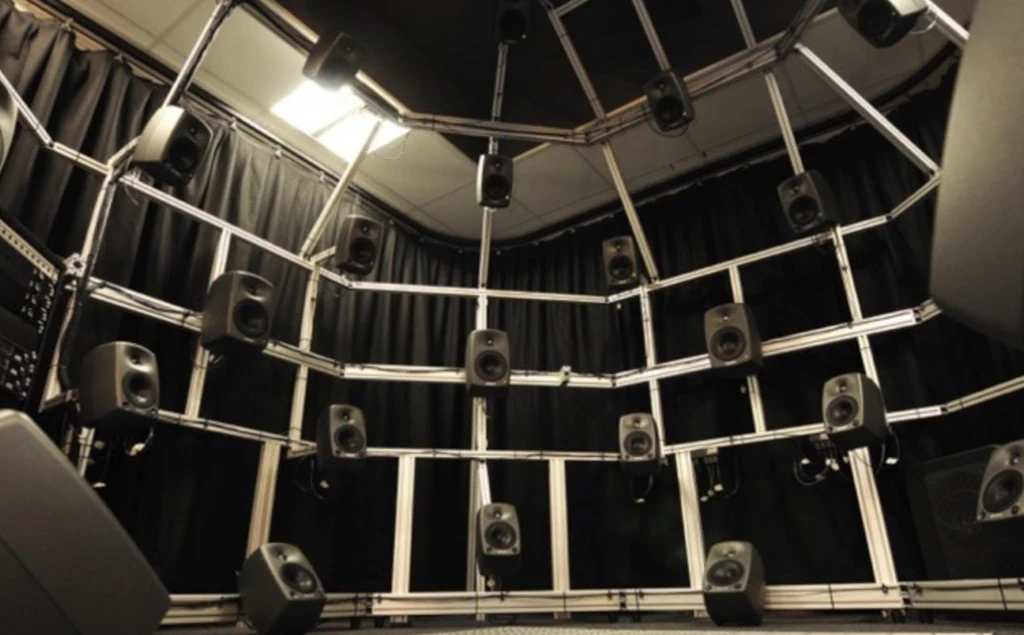DARCI S01 Ep.12
In this episode Mariana interviewed Professor Hannah Thompson, a partially blind academic and activist whose work focuses on the intersections between critical disability studies and French studies. Find out more.
The Enhancing Audio Description II project seeks to explore the potential of sound design practices and spatial audio to provide accessible film and television experiences for visually impaired audiences. It fuses audio technology and creativity to widen the notion of media accessibility and increase the quality and quantity of provision, providing cutting edge techniques to the UK cultural sector.
Enhancing Audio Description II: implementing accessible, personalised and inclusive film and television experiences for visually impaired audiences, is a project that proposes a new paradigm in accessible experiences, in which there is not an overreliance on a narrator's spoken word, as in traditional Audio Description practices. Instead it utilises new accessibility features that include: the addition of sound effects, the spatialisation of dialogue and sounding objects, and first-person narration, to provide accessible experiences that are seamlessly integrated to the soundtrack of a film or television programme. These techniques are integrated into film and television workflows from the development phase up to final delivery.
The project builds up from previous research which demonstrated the success of these methods, and explores them even further, by concentrating on the conveyance of cinematographic elements through sound, the exploration of the intricacies of using first-person narration across different genres and different cast sizes, as well as exploring how spatialisation techniques can be adapted for multi-listener scenarios for a variety of loudspeaker formats. The exploration of these methods will be conducted with an end-user centred approach, in which visually impaired audiences are consulted from the design process up to delivery. Furthermore, the project explores the creation of guidelines that will allow the incorporation of these methods to professional broadcasting pipelines and film workflows, by collaborating with a Project Advisory Panel representative of the different roles in film and television as well as end users.
In this episode Mariana interviewed Professor Hannah Thompson, a partially blind academic and activist whose work focuses on the intersections between critical disability studies and French studies. Find out more.
In this episode Mariana interviewed Michelle Duxbury, who challenges traditional art hierarchies by exploring identity, body & landscape through embroidery, film & installation, as a disabled/neurodivergent, and multidisciplinary artist from a working-class background. Find out more.
In this episode Mariana interviewed Ana Tamayo, whose research focuses on audiovisual translation and accessibility in different modalities, and specifically on media accessibility and minoritised languages, mostly Basque and sign languages. Find out more.
The EAD methods featured in The Mix Room with Genelec podcast. Find out more.
In this episode Mariana interviewed Jonathan Penny, who currently oversees the delivery of subtitles, audio description and signed content for Channel 4's linear and on-demand platforms. Find out more.
Mariana's talk titled 'On Roses and More... reflections on inclusion in sound design practices' for the Women in Research Network now is available online. In her presentation she shared insights from her personal journey of inclusion and exclusion, alongside our innovative EAD research. Find out more.
In this episode Mariana interviewed Elle Chante, a UK based musician exploring the reality of complex mental health and disability into her work. Find out more.
In this episode Mariana interviewed Dr. Samantha Moore an animator and researcher with an interest in documentary, science and art, practice as research. Find out more.
In this episode Mariana interviewed Dr. Kulnaree Sueroj, who has recently graduated with a PhD from the School of Arts and Creative Technologies at the University of York. Find out more.
On the 18th of May 2024 the Enhancing Audio Description team headed to Edinburgh to host a one-day symposium at Dovecot Studios focused on discussions and reflections on accessibility in relation to different creative areas, including music, dance and filmmaking. Find out more.
In this episode, Mariana interviewed Amelia Cavallo, a blind, USA-born theatre practitioner, academic, and workshop facilitator who works as a multidisciplinary performer, musical director, lecturer, and consultant on access and audio description. Find out more.
In this post, Dr Monika Zabrocka, a visiting researcher in the School of Arts and Creative Technologies (University of York) summarises her work and how it is connected to our EAD project. Find out more.
We are delighted to announce Amble Skuse, one of our symposium speakers in Edinburg this May. This post features the abstract of her presentation and her bio. Find out more.
Our team carries out focus groups, interviews and other sessions on a regular basis. If you are visually impaired and are interested in participating you can sign up to our participants' mailing list below to find out about the opportunities available.
